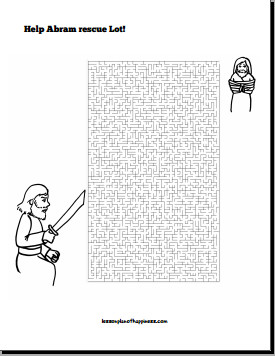(Back to OT Junior Seminary Overview)
Old Testament Lesson 12: Genesis 13-14
To Prepare: Read Genesis 13-14; print a copy of the activity below for each child participating. The maze is available in 3 difficulty levels to match different skills and ages.
To Teach: Begin with a prayer. Explain that in the Old Testament, sometimes people changed their names through their lives. Abram is another name that Abraham used, so when it says Abram we’re still talking about Abraham.
Abram and Lot left Egypt and settled together in the land of Canaan. Read Genesis 13:6-7 and explain that there wasn’t enough land to support both Abram and Lot’s cattle. Ask what they think Abram and Lot will do. Read Genesis 13:8-9 to see what they decided to do. Talk about how even though Lot took the most fertile land in Jordan with the best grass and water, Abram didn’t fight with him. He decided it was more important to be a peacemaker than to take the best place, so he left with everything he had and settled in the land of Canaan.
Lot pitched his tent close to the city of Sodom. Today, Sodom is remembered as a very, very wicked city. Explain that the people of Sodom were at war with neighboring kingdoms, and they captured Lot and all of his people. Read or summarize Genesis 14:13-16. One of Lot’s people escaped and reached Abram to tell him about Lot’s capture. Abram armed hundreds of his servants and chased them, and in the night time they attacked, rescuing Lot, his people, and his wealth.
After this rescue, Abram was met by two of the kings. One king, the righteous king Melchizedek (sound familiar?), offered him a blessing, which Abram accepted. The wicked king of Sodom, on the other hand, attempted to strike a bargain. If Abram would return Lot and all his people to the king of Sodom, he would allow Abram to keep all of Lot’s wealth, making him even richer. Abram refused to take this bargain. Why do you think Abram accepted something from one king but not the other? What would you have done if you were Abram?
Let kids complete the maze to finish up the lesson. That’s it, you’re done!




